Powered by Metonomy.
The amount of knowledge on meta skills (Learning how to learn) is growing exponentially. It is difficult to keep up with the speed of new techniques, experiences and tools developed to learn more effectively.
With the purpose of updating what I know -and what I don’t know- about learning new skills, I decided to join the course ideated by David Kohler, one of the most experienced learning specialists I know of.
The promise
In this 9-week training, the promise was to develop your skills as a trainer in a group of 6 people. Although it seemed a big commitment (4h/sessions was not something that I had done since uni), I was curious about it so I decided to give it a try.
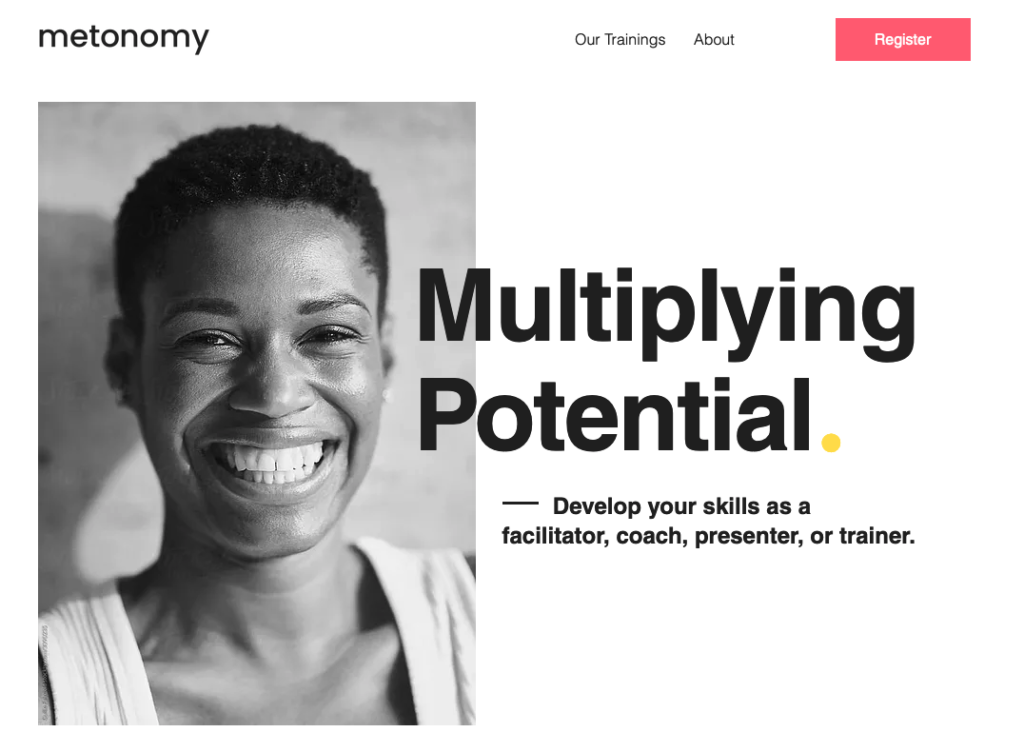
The approach was clearly innovative, combining theoretical modules and practice environments where trainers could experiment with new approaches to facilitating learning. These were some of the goals showcased at the Metonomy website:
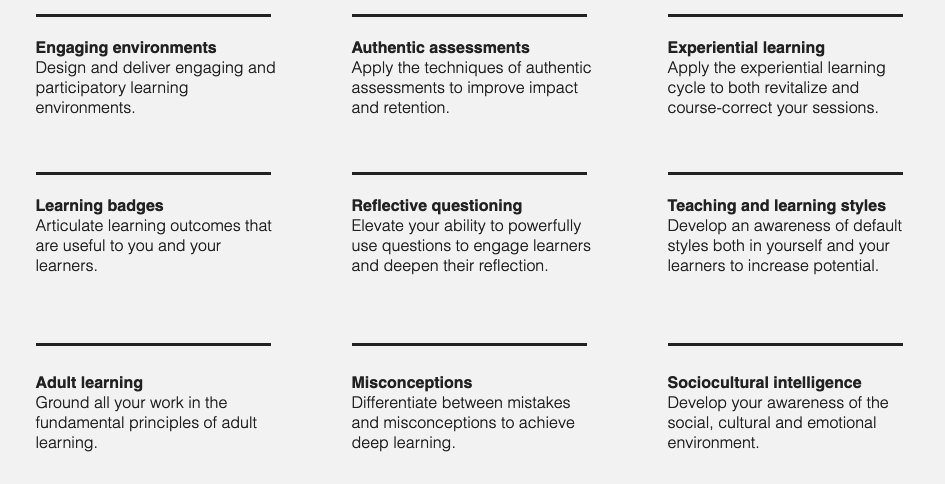
As many of the Minds Studio projects involve some kind of training, or design of learning environments, it seemed like a very good fit. Trained as an engineer, I felt this meta-skills training program could have a good impact on my theoretical knowledge about learning. It didn’t require any previous experience, so I enrolled in the next available cohort.
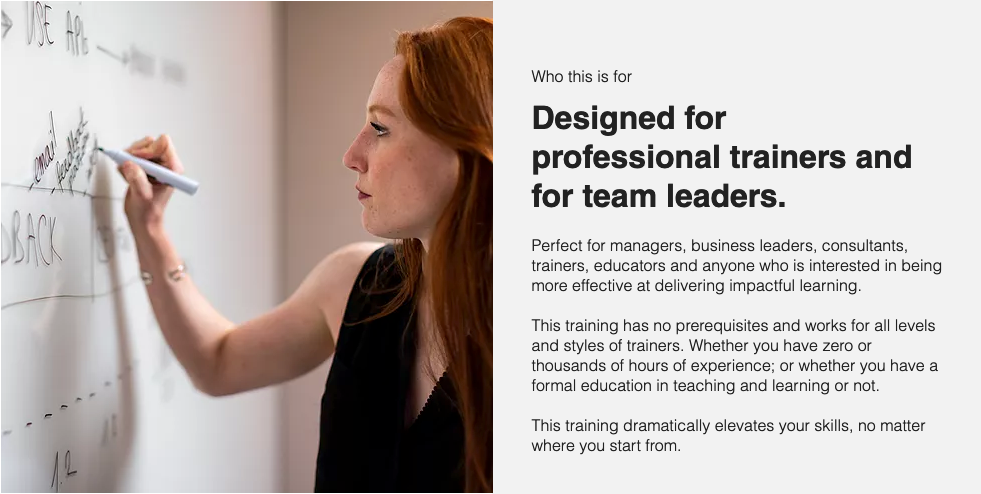
My main conclusions after the 9 weeks
If you don’t have much time, these are the main takeaways I bring home after spending 3 months on the Metonomy Skills for Trainers program:
you are probably doing it wrong
No matter how much experience you have training others, this experience showed me there is SO MUCH space to improve the way we design our programs. During the course, we had several opportunities to practice curriculum design, learning goals setting and delivering under time pressure. Having someone observing you, and giving you actionable feedback is a fantastic experience -if you are open to it-.
Nurture an effective learning environment
And that is not reading slides and thinking you are the smartest person in the room. Creating and nurturing an effective learning environment starts by having a clear set of learning objectives (That could be cognitive, but also psychomotor or affective). Once the goal is clear, using a proper lesson planning structure that matches the goals, combining 4 elements: conceptualizing, experimenting, experiencing and reflecting is the key to enable it.
What this means is that subject-matter expertise is not enough. You need pedagogical expertise too if you really want your students to walk out of the room having learned something for the long run.
Practice makes humble
During the course of 9 weeks, you design and implement 4 practical training sessions on different topics. All the other members of the group do it too, and you give feedback to each other. I can’t express the amount of lessons learned during the practice sessions. It is incredibly humbling to receive inputs again and again about your -probably outdated- ways of planning and implementing your course curriculum.
This is where I want to thank Gabi, Olivia, Soley, Helena, Sweta – and David, of course- for the valuable – and humbling- feedback provided. The course also provides a strong foundation on how to express performance-based feedback, which is incredibly useful inside or outside a training class.
Stop the guided tour and experience more
Measuring the time you talk while conducting training sessions is a very effective tool to keep track of how controlling you are as a trainer. If you are like me, you tend to design “guided tours, leaving little space for the learners to freely explore new areas of knowledge. By working on specific examples, one of my main take-aways has been to create learning experiences much more relaxed and exploratory.
An example could help capture this concept visually. If you were interested in learning about impressionism at a local museum, one approach would be to learn about it by buying a tour where someone would talk 90% of the time. You would hear about artists, dates, masterpieces, and we will probably forget the next day most of the information. That is the guided tour. There is a different way to approach this goal, by involving the audience in experiencing what impressionism is, reflecting on it, and applying it to their lives. Maybe that could involve exploring those artworks that inspired you, reflecting on why that happened and sharing it with a group. You could then attempt to draw your first impressionist piece. Receive feedback from an expert and your classmates. And so on.
Checking in and out
There is something softer, apart from the different tools and concepts shared during the sessions, that I bring with me from this course. I loved the way David checked in at the beginning and summarized what happened at the end of the sessions. It felt very cozy, warm, like catching up with a group of old friends before and after working hard. I think this is an important skill to master when you facilitate groups of people -especially online- as we tend to go directly to the subject that we need to discuss. People arrive to a training session in different states of mind, and before jumping on any task, it is worth listening and acknowledging them.
And yes, it’s worth it
As many great things in life, the course comes with a high price tag (Nearly $1,400 for corporate clients, and a cheaper options for non-profits, freelancers and students), but I definitely believe that it is a fantastic experience that empowers trainers to raise their game and provide a much more effective training. If you are currently a facilitator in a company, it is a perfect training for you. If you are a freelancer, I still believe it is worth the investment. David’s experience is gold and it will help you grow faster than any book or podcast.
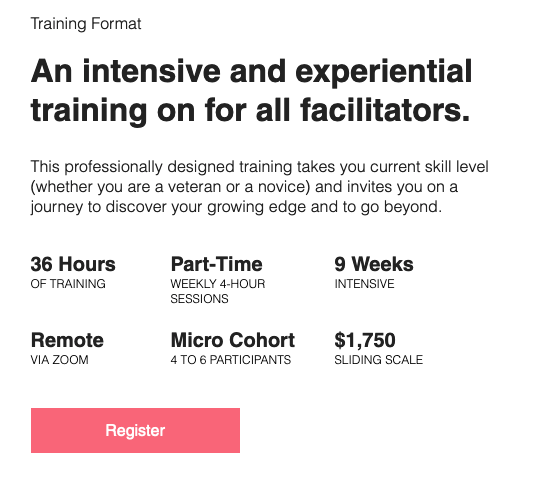
The -longer- learning journey report
Since the beginning, the course is very different from any online learning course I have ever seen. The welcome email only asks you to create a Miro account, that is the central point where the course is going to take place. Instead of having endless videos to watch, there is no pre-recorded materials at Metonomy. Everything happens in a Zoom room with a group of 6 people.

After getting everyone up to speed on how to use this tool, it becomes really interactive to participate in the session. Although the content is well structured and there is always a clear goal, there is flexibility to explore whatever the group is interested in discovering. This is a key learning I take with me, as sometimes things are planned in a certain way, but opportunities appear to experience something differently. As a trainer, you are supposed to detect those opportunities and focus on the learning experience, not just following a lesson plan.
SESSION 1: Defining training, curriculum and learning objectives.
After a round of introductions, the course starts from the basics of defining what the purpose of training is, and what differentiates it from other forms of facilitation or coaching.
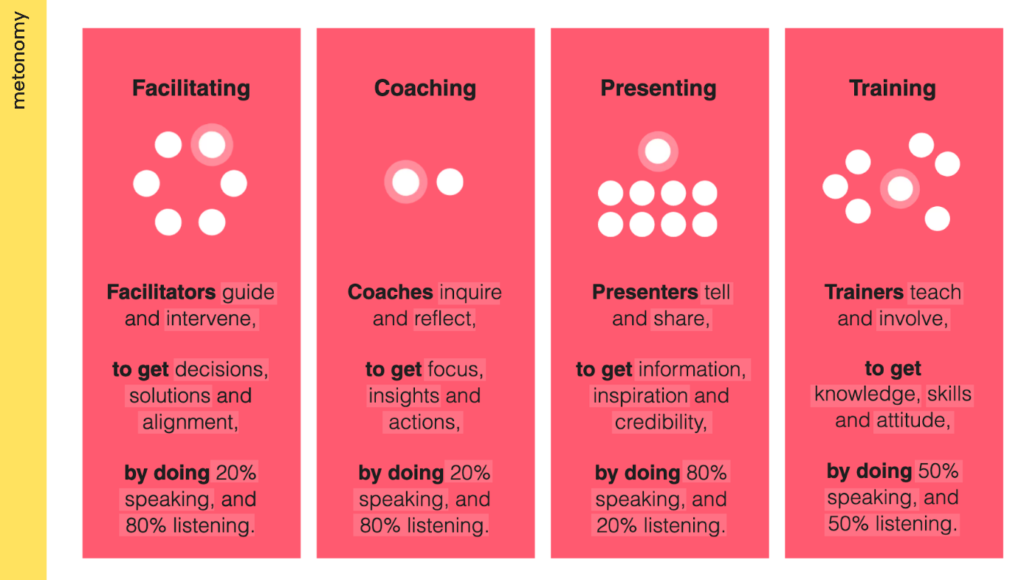
As we all come to training with a different set of expectations, I found it very interesting to have to define and explain why I was going to spend 9 weeks learning about this, and what were my expectations of what I was about to experience. This is what I came up with:
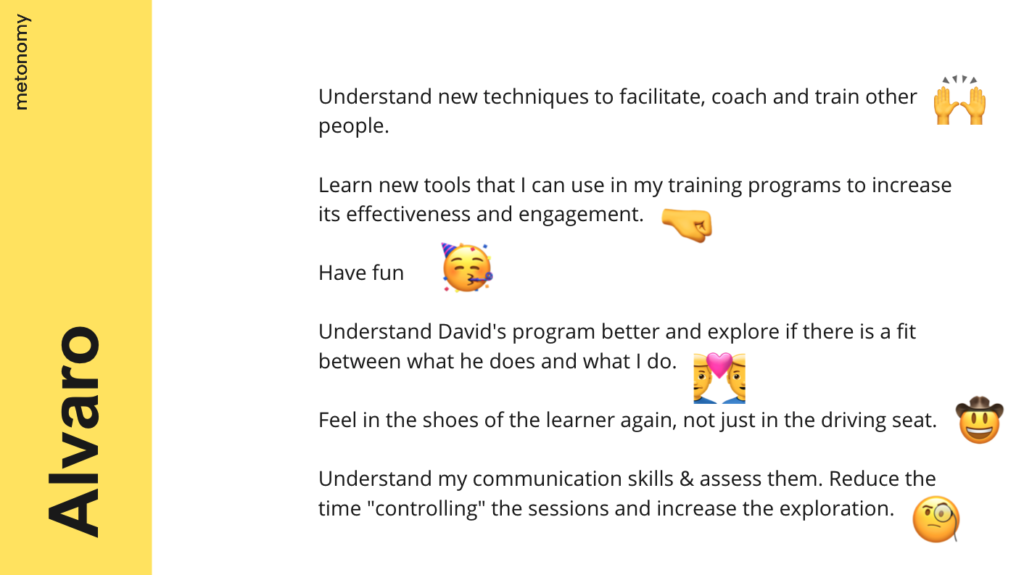
The first key learning of this session for me was to understand that trainers are supposed to design and nurture an effective learning environment, combining subject-matter expertise (know the subject), subject-pedagogy expertise (Know how to master the subject) , and pedagogical expertise (Know what it takes for someone to learn).
The second was to learn how to design an effective curriculum, including goals, activities and assessments that allow us to effectively train others into learning a new skill. It was mind-blowing to practice how to write proper learning objectives, as it is usually the source of problems in class when they are not well defined.
A good learning objective describes a resulting competency, the environment that will be available to the student, and the criteria to know what has been achieved. Practising with the group how to set up good learning objectives was one of the most useful concepts in the course.
And finally, we went into lesson planning, where we discovered that there are frameworks (Such as BOPPPS or COARDS) that can be used depending on the domain of the learning objectives that have been set (cognitive, psychomotor or affective).
SESSION 2: planning and executing a training experience from scratch.
With a new set of tools under our belt, we went straight into practising in session 2. But before we got started, we had an important conversation about feedback.
Feedback is one of those things that we all say we like to receive, but we struggle to take when it is given. Many times, because we mix judgement with actionable performance-based feedback, our comments to others are not as effective as they could be.
It was an incredible learning experience to practice performance-based feedback during the second session, with practical examples of what other colleagues were presenting. It was also very fulfilling to receive feedback based on performance, without making it personal.
As the time was limited for our training sessions, it was interesting to observe how most of us tried to squeeze many learning objectives in a short period of time, making the training session very ineffective. We also tend to talk way too much, and we do not encourage enough participation in the audience. Even having extensive experience in teaching and designing education programs, it was humbling to be back on the whiteboard and question some of the most basic assumptions of our training.

session 3: active learning and assessments
After our first hands-on activity, it was time to go back to the drawing board and analyse what was happening. Why did our sessions seem so passive and lacked interaction?
One of the Aha! moments of the whole course was the discussion about mental models, and how you need to deconstruct and break a mental model that is not working anymore, in order to be able to build a new one that works. (A fantastic example about this is the whole earth is flat vs earth is round experience)
After a fantastic discussion about mental models, we got into one of the beefiest concepts of the course: The Active Learning Cycle.

Although the concept is not new to many of us, it was the practice of that cycle in different situations that made it stick with me. In order to update our mental models, it is not enough to “tell people” a new way to think. It is the process of conceptualizing, experimenting, experiencing and reflecting that achieves that goal.
But what about assessment? It is so common to assess students using tests and exams, that we forget the actual purpose of assessing people. During this session, we explored 3 different kinds of assessment (assessment of learning, assessment as learning, and assessment for learning) and we committed to use the new tools we acquired in the next practice session.
session 4: implementing a training session using active learning and assessment
The second time preparing a lesson plan from scratch was interesting. We definitely became less ambitious about the material we will include, and we started introducing ways of assessing our participants’ knowledge in the topic we were about to discuss beforehand. I decided to use a tool called Mentimeter in order to get quick feedback from the audience instead of having to speak all the time.
The change was quite dramatic. All the training sessions on the second round were much more interactive, and although time was still an issue, we generally managed to complete our lesson plan within the timeframe. The feedback received from the participants was much more encouraging:
“Loved it, it’s so interactive right away.”
“Was engaged throughout. Not having to speak gave it more of a pace.”
However there were still challenges that participants brought up, that kept pointing towards some of the tendencies detected in the first training session. “The slides were too small”. “There was too much data to absorb”.”The post-testing activity didn’t match the learning goal”, were some of the inputs that I got from other participants and the trainer.
Overall, I felt progress. It was clear that it was far from perfect, but engagement was way higher and the whole experience was more enjoyable for the participants. Some of them expressed they would like to continue learning about it after the class!
SESSION 5: I HAD TO DROP
Something I realised during the course of the 9 weeks, is that committing to 4 hours of training could become really challenging on top of the work-week. I managed to juggle things during the first month, but at the beginning of the 2nd month it became too much, and I had to skip a session. I would say that at some point, all the participants needed a break, and this might be a good piece of feedback for Metonomy. Maybe a week of rest between the first month and the rest of the course could have helped us to breathe a bit between the sessions.
This also made me realise how challenging adult learning is. Even if you are interested, committed and motivated to participate in a learning activity, sometimes life is just too much. And that is ok, you should design programs with that in mind.
SESSION 6: PRACTICE ROUND 3, THINGS STARTED TO FLOW!
The third time I approached the exercise of preparing a training session from scratch, I felt I had experience in it, and I think this was my best session. As I had been quite controlling on my approach in the first 2 rounds, now I tried to play with the format to give more space to the participants, so they could explore more freely.
I designed the session so they could learn about each other’s passions. With a very simple game, the group had to write down things they are passionate about and try to guess who wrote what. The session was playful, simple and the flow was very smooth. The feedback was much shorter this time, and sweeter:
“It was fun, engaging and interesting topics, we are naturally drawn towards learning about this stuff.””It was great to learn more about each other”. There were comments related to the time, but not due to the lack of planning, but the willingness to continue playing the game. The environment of learning was there, and they enjoyed it.
By this time, I felt the entire group had already mastered how to prepare a good learning plan, with a clear and achievable learning objective, and an assessment that helped the group strengthen what was learned. We have definitely gone a long way in just 6 weeks.
As we all were getting better at it, David started helping us improve our questioning during the session, and helping us understand how we could improve our way of interacting with our audience (Saying “Any questions?” is not the best way to keep people engaged and inspired!). These are some of the pointers given during that day:
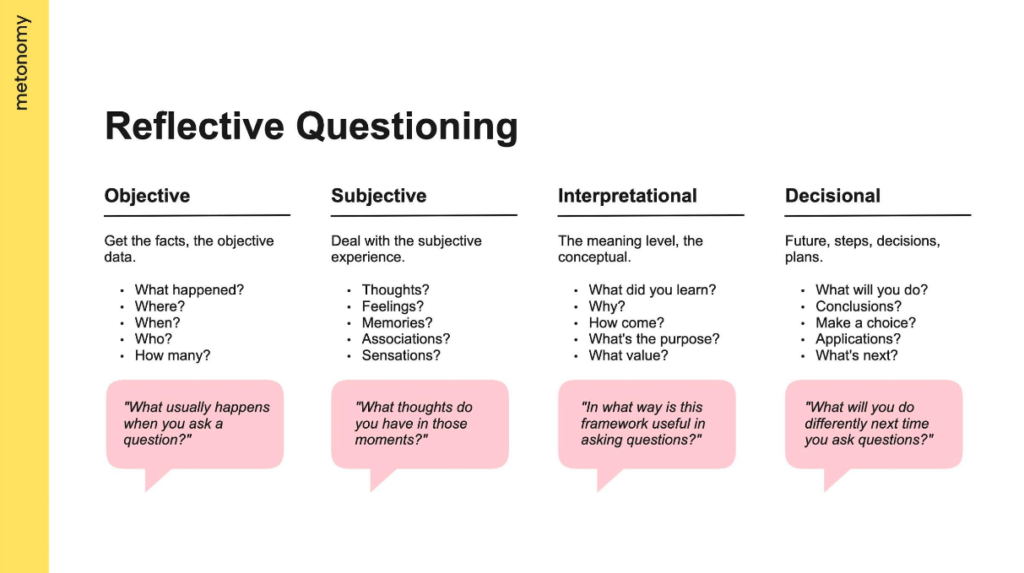
Session 7: other formats that we can use in our trainings.
As we got better in creating our training and making sure our participants were engaged in the process of learning, it was time to get inspired and increase our “vocabulary” on the training formats.
One of the greatest toolboxes shared during the course was liberating structures, a collection of interaction formats that can help facilitate groups of people to work together. We didn’t go through the 100s of potential formats that can be used, but we explored some of them. The Samoan circle or the Troika consulting were very interesting activities to participate in, and they provided a fresh new approach to interactivity with the audience.
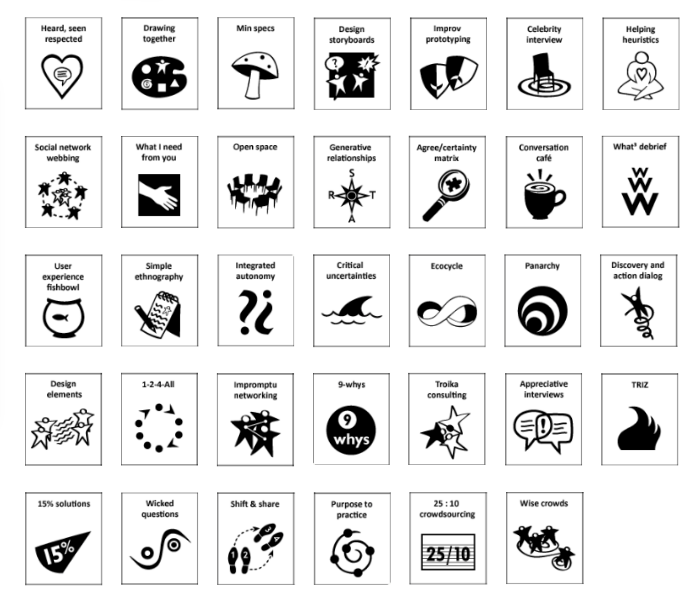
By this point, the group knew each other really well, and we focused on feedback to keep increasing the effectiveness of our training. I felt like the group took over and David was simply facilitating us giving each other feedback to improve, and that felt really great. Now he was just challenging us to go further and crazier in our last training practice. Pushing us out of our comfort zone already!
SESSION 8: EXPLORING THE LIMITS
In the last practice session I felt like driving a fast car, exploring the limits that can be reached without breaking the engine. I started the session asking the participants to close their eyes, and imagine their last holiday. The goal was helping them experience something, before starting even to discuss what the learning goal was.
The approach was completely exploratory. The goal was to create the environment where the participants could learn about how others prepare and plan their yearly time off. However, the approach to reach the learning goal through an active learning cycle had completely transformed the learning plan. Now it was less of a guided tour, and more of a learning experience. Something had happened in the last 8 weeks! Maybe that “something” is called learning 🙂
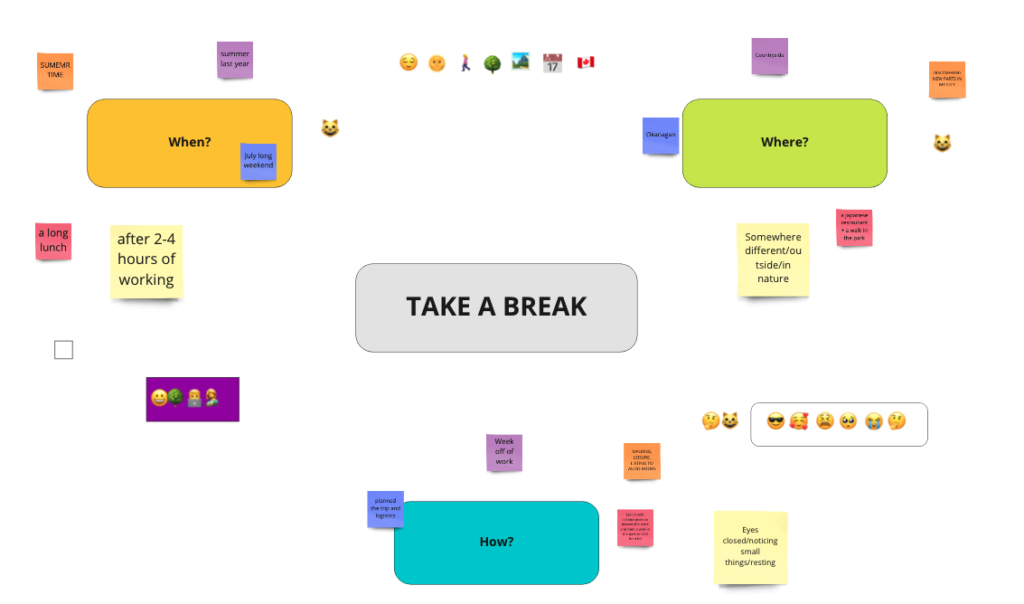
As with any experimental sesion, some things didn’t go as expected. But that was totally fine at this point. We had a strong “safe” approach to planning our training sessions, and we were just given space to play and explore other approaches to generate and nurture learning environments.
Session 9: wrapping up
The last session was mostly reflection about what we have learned in the last 8 weeks. It was also time to wish each other well and keep the connections for future opportunities. It did feel like a sweet and sour moment, because by this time the group was comfortable with each other and the pace of learning had accelerated towards the end.
Something I would have added to the course is some sort of peer to peer credit, that could help each other showcase our experience as trainers to third parties. At the end of the course I expected a credential that could allow others to verify the skills that have been acquired. Probably something like Accredible or Credly is something that could be added to the product in the future.
All in all, the experience has been fantastic and has opened my eyes to keep exploring ways to improve the way we learn and facilitate learning. I am very grateful to David, whose patience and leadership during the entire training has been incredibly inspiring to me.
Looking forward to my next Metonomy course!